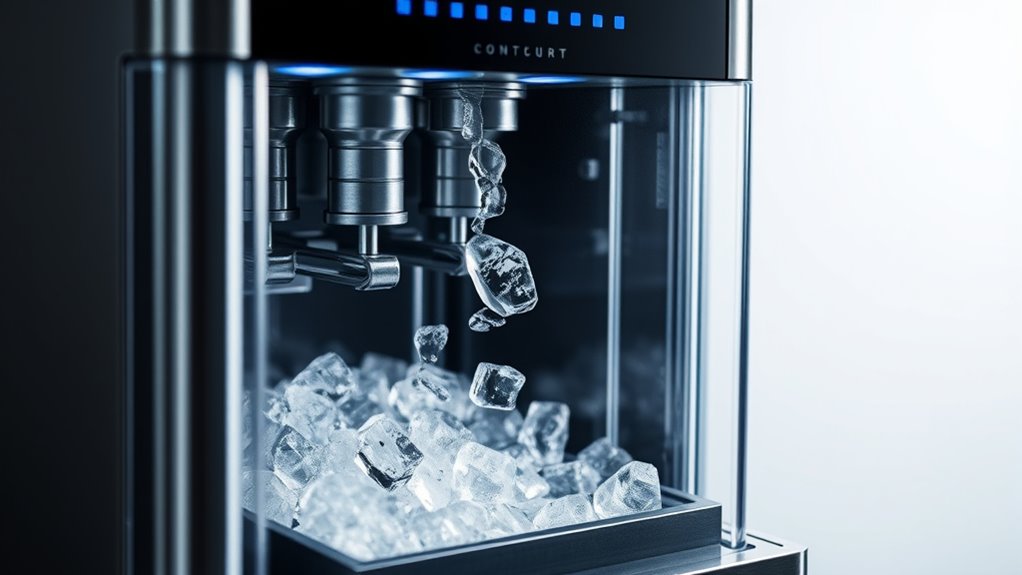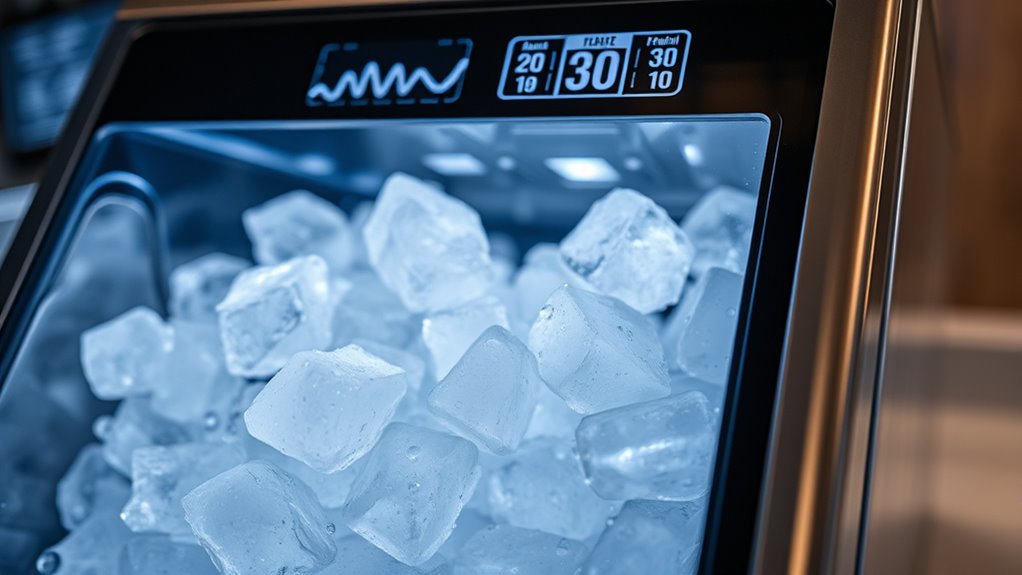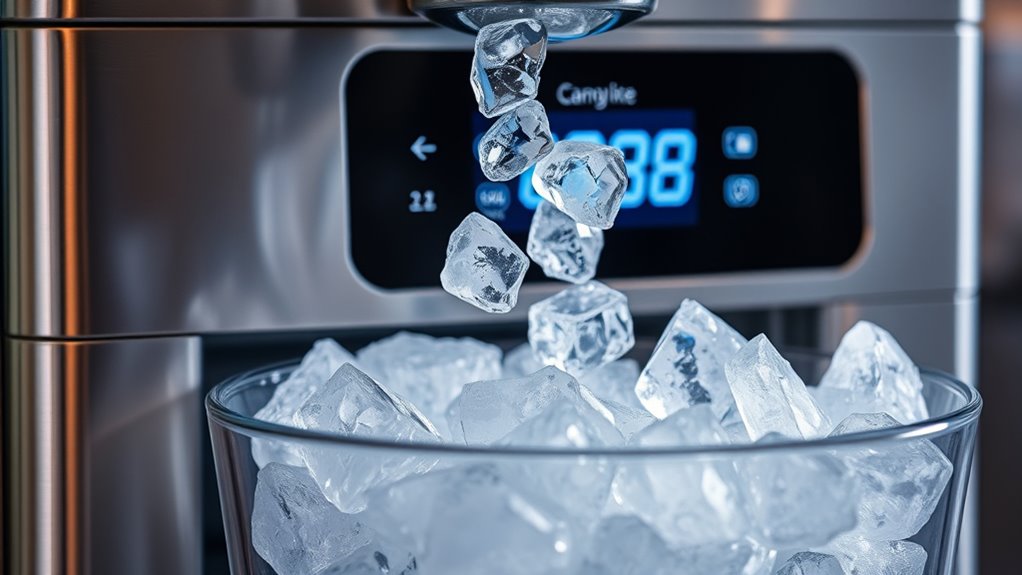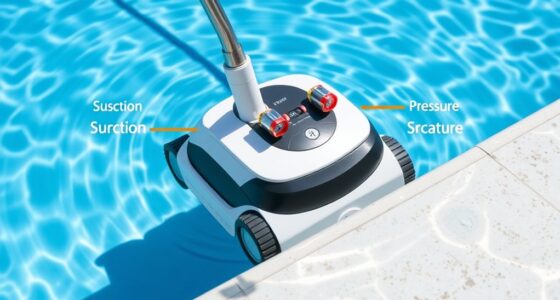Countertop nugget ice makers use rapid freezing of thin water sheets on super-cooled metal surfaces to create porous, sponge-like ice with a soft, chewy texture. Precise temperature controls, efficient heat transfer, and specialized shaping techniques trap air pockets, resulting in ice that melts slowly and absorbs flavors well. If these scientific principles sound fascinating, there’s much more to discover about how advanced engineering makes this ice so uniquely enjoyable.
Key Takeaways
- Countertop nugget ice makers use rapid freezing of thin water sheets on cooled metal surfaces to create porous, chewable ice.
- They rely on thermodynamic heat transfer and precise temperature control to produce uniform, soft ice nuggets.
- The porous structure traps air pockets, which slow melting and improve texture and flavor absorption.
- Efficient water flow and surface materials like stainless steel optimize ice formation and energy use.
- Advanced sensors and automation regulate cooling, compression, and scraping, ensuring consistent nugget size and quality.
The Scientific Principles of Ice Formation and Texture in Nugget Ice Makers

Nugget ice forms through a precise process where thin water sheets rapidly freeze on a super-cooled metal cylinder, creating a porous, sponge-like structure. This rapid freezing results from thermodynamic principles that control heat transfer, producing small, uniform ice shapes. This process is heavily influenced by heat transfer processes, which determine the size and consistency of the ice by managing how heat is removed from the water. The porous structure slows the melting rate, prolonging cooling and minimizing beverage dilution. Additionally, the thermal conductivity of the metal surface plays a crucial role in how quickly heat is extracted, affecting ice formation efficiency. Auger compression then presses the layered ice sheets, trapping air pockets that give the ice its softer texture and enhanced chewability. Fluid dynamics influence water flow and shaping through small holes, forming rounded nuggets with a characteristic bite. Sensors and automated controls monitor ice levels, optimizing ice production by regulating water flow and compression cycles. This scientific approach guarantees consistent, high-quality nugget ice with ideal texture and melting properties. Furthermore, the AI security technology within modern nugget ice makers contributes to improved monitoring systems and safety features.
The Engineering of Water Flow and Cooling Systems in Countertop Models

The water flow and cooling systems in countertop nugget ice makers are meticulously engineered to guarantee efficient and consistent ice production. The refrigeration system, including the compressor and condenser, removes heat from the refrigerant, maintaining the low temperatures necessary for ice formation. The cooling surface, a cylindrical metal, is kept below freezing, around -10°C to -15°C, to facilitate ice sheet creation. Water is carefully channeled through flow pathways and water channels that minimize thermal resistance, ensuring uniform distribution over the cooling surface. This precise water flow allows for steady ice sheet formation, which is then scraped into nuggets. Properly designed cooling system components ensure optimal performance and durability. The automation in manufacturing of these systems enhances precision and consistency during production. Advanced temperature regulation techniques are employed to maintain the ideal conditions for ice formation. Implementing thermal management strategies further contributes to energy efficiency and system reliability. Additionally, integrating sensor technology helps monitor system performance and prevent malfunctions. Optimized design of these systems not only enhances ice quality but also maximizes production speed, ensuring your countertop nugget ice maker runs reliably and efficiently.
Compression and Shaping Techniques That Create Chewable Nugget Ice

To create the signature chewable texture of nugget ice, countertop models use an auger to scrape soft ice sheets from a super-cooled cylinder and then compress them into small, porous nuggets. The compression process shapes the ice sheets into a specific form, often through a nozzle or small holes that define the shape. During compression, the porous structure of the ice traps air pockets, making the nuggets lightweight, soft, and chewable. This shaping mechanism ensures each nugget maintains a consistent size and texture. The continuous movement of the ice through the shaping components guarantees uniformity and efficient production. Additionally, the porous structure of the ice is crucial for achieving the desired chewiness and quick melting properties. Understanding the mechanics of ice compression helps explain how these machines produce such distinctive ice. Moreover, the material properties of the ice influence how well it maintains its shape during compression and melting.
Factors Influencing Melt Rate and Ice Quality in Home Appliances

Several factors influence how quickly nugget ice melts and how long it maintains its quality in home appliances. The melt rate depends on the ice’s porosity and surface area; more porous nuggets with larger surface areas melt faster due to increased heat exposure. Thermal conductivity of the ice and surrounding materials also affects how quickly heat transfers, impacting melting speed. Water temperature and ambient humidity play *vital* roles—warmer air and higher humidity accelerate melting and reduce ice longevity. Ice density, shaped during manufacturing, influences porosity and, consequently, melting behavior. Features like insulation and precise refrigeration controls help slow the melt rate by maintaining lower internal temperatures and minimizing heat transfer, ensuring better ice quality and longer-lasting nugget ice. Additionally, filtration systems can improve ice quality by removing impurities that might affect melting rate and texture. Understanding environmental conditions, such as room temperature and humidity levels, can further optimize the performance and longevity of your nugget ice maker. Proper beneficiary designation in your appliance setup can also ensure consistent maintenance and performance over time. Maintaining optimal refrigeration performance is essential for controlling internal temperatures and preserving ice quality over extended periods.
Innovations and Scientific Validation in Modern Nugget Ice Technology

Advancements in refrigeration technology and material engineering have transformed how modern countertop nugget ice makers produce and maintain ice quality. Scientific validation confirms that innovative refrigeration and auger mechanisms optimize ice production, ensuring consistent, chewable ice with controlled melt rates. The porous structure of nugget ice enhances flavor absorption and cooling efficiency, supported by studies on surface area and porosity. Precise temperature control and durable materials like stainless steel improve energy efficiency and durability. These technological improvements allow adjustable compression and scraping techniques, resulting in softer, uniform ice that melts slowly, maintaining beverage temperature longer.
| Feature | Benefit |
|---|---|
| Porosity & Surface Area | Better flavor absorption, prolonged cooling |
| Temperature Control | Consistent ice texture and energy efficiency |
| Auger Mechanisms & Material Engineering | Faster production, durability, chewability |
Frequently Asked Questions
How Does the Nugget Ice Maker Work?
You ask how a nugget ice maker works. It cools a metal cylinder with refrigeration, creating a super cold surface. Water continuously drips over this surface, freezing into thin sheets. An auger scraper then collects, pushes, and compresses these sheets into small, soft, chewable nuggets. Sensors keep the process running smoothly, ensuring you always have fresh, ready-to-use nugget ice in your collection bin.
How Does the Countertop Ice Maker Work?
Imagine a tiny winter wonderland inside your countertop, where cold magic unfolds. You turn it on, and water drips onto a chilled metal surface, freezing into thin sheets. An auger then scoops, compresses, and shapes these sheets into soft, chewable nuggets. Sensors monitor the ice level, guiding the process. In this icy ballet, your machine transforms water into the perfect crunchy, chewy treat right on your countertop.
Should I Leave My Countertop Ice Maker on All the Time?
You might wonder if you should leave your countertop nugget ice maker on constantly. It’s best to turn it off when you’re not using it for extended periods. Continuous operation increases energy use and can cause wear on the compressor. Plus, it may lead to mineral buildup or mold if not cleaned regularly. Turning it off saves energy, extends its lifespan, and keeps your ice fresh and safe.
Why Do Countertop Ice Makers Stop Working?
Think of your countertop ice maker as a busy little factory that can hit a snag. It might stop working because water lines are clogged or frozen, blocking the flow of life-giving water. Low water levels, mineral buildup, or faulty sensors can trick it into thinking everything’s fine while it’s actually struggling. External issues like power surges or overheating can also throw it into a shutdown, leaving you without that invigorating ice.
Conclusion
Think of your countertop nugget ice maker as a skilled artist, transforming water into invigorating sculptures that delight your senses. Each ice nugget is crafted with scientific precision, like a master sculptor shaping a masterpiece. When you enjoy that perfectly chewable ice, you’re experiencing the harmony of engineering and science working together—turning simple water into a cool, comforting symphony. Embrace the magic behind every icy bite; it’s science you can taste and trust.









